Tobacco use among adolescents in Scotland: profile and trends
The report presents analysis of trends and associations for smoking amongst 13 and 15 year old pupils between 1990 and 2013. Smoking is at its lowest level since the survey began.
This document is part of a collection
5. EQUALITIES
DEPRIVATION
Deprivation is a key predictor of all of substance use, including smoking. In countries with highly developed tobacco control policies, individuals living in poverty and deprivation are disproportionally likely to be smokers. The Scottish Index of Multiple Deprivation (SIMD) is the Scottish Government's tool for classifying geographic areas ('data zones') in terms of deprivation, providing a relative ranking from 1 (most deprived) to 6,505 (least deprived) . These are commonly grouped as deciles or quintiles.[36] Adults in the most deprived SIMD quintile in Scotland are considerably more likely than those in the rest of the country to be current smokers 34 per cent and 18 per cent, respectively, and smoking drops to 9% in the least deprived quintile.[37] SALSUS allows us to investigate if deprivation has a similar association with smoking for adolescents.
Pupils responding to SALSUS are asked for their home postcode and this is used to identify the SIMD quintile they live in. Pupils from the most deprived areas are more likely to be regular smokers than those from the most affluent areas, but the difference is not as great as it is for adults and it has shrunk slightly over time. While 9% of all 15 year olds smoke regularly in 2013, 12% of those in the most deprived quintile smoke regularly. Differences in parental smoking within deprivation quintiles are more stark, as shown in Figure 5.1. For example, 46% of pupils living in the most deprived quintile report that a parent smokes.
SALSUS includes other measures of deprivation - an objective measure by asking if the child is eligible for free school meals and a subjective measure by asking the respondent how well off they feel their family is. These are individual measures of deprivation rather than the area measure provided by SIMD.
Free school meals are provided to those whose parents receive benefits or incomes fall below a certain threshold.[38] Pupils who receive free school meals are far more likely to be regular smokers than those who do not. The gap between them has remained constant over time at roughly 10% (Figure 5.2) so that by 2013 16% of regular smokers received free school meals compared to just 7% of non-smokers. Pupils in receipt of free school meals are also more likely to have parents who smoke.
Figure 5.1 -% in SIMD quintile who smoke: respondent and parent(s)
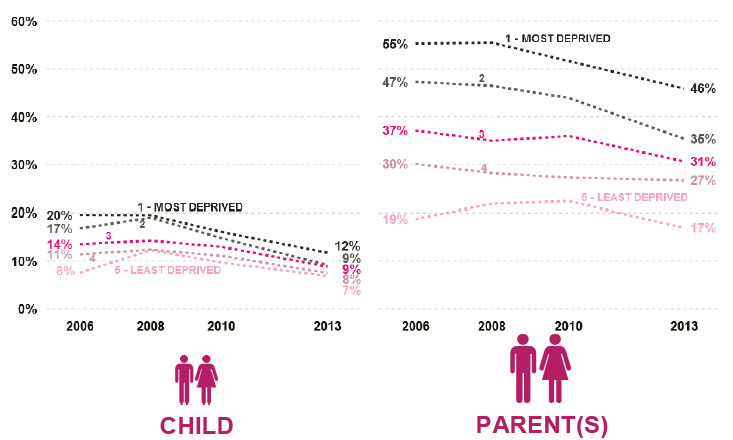
Base: all 15 year olds (full bases in Appendix A, Table A.13)
Figure 5.2 - % receiving FSM: by smoking status of respondent and parent(s)
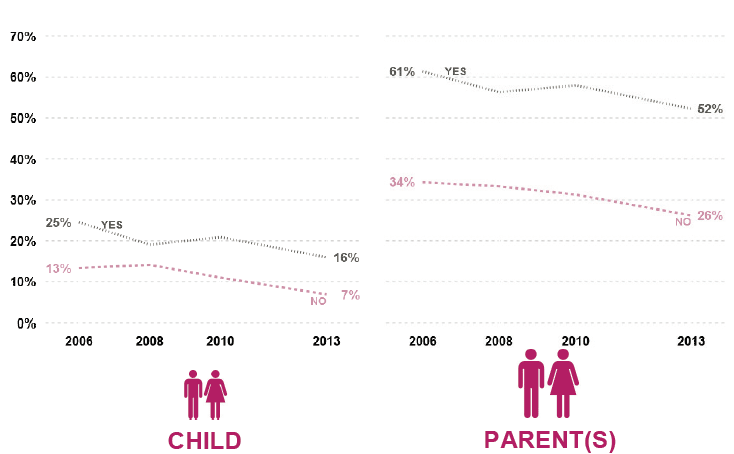
Base: all 15 year olds (full bases in Appendix A, Table A.13)
Pupils are asked how well off they think their family is, ranging from 'very well off' to 'not at all well off'. Those who believe they are 'not well off at all' are more likely to be regular smokers. Similarly, those who responded that they were 'not well off' or 'not at all well off' were more likely to have at least one parent who smokes. Notably, the 'not at all well off' group has remained relatively static between 2006 and 2013 for parental smoking (Figure 5.3).
Figure 5.3 - % in different 'well off' ratings who smoke regularly - pupil and parent(s) smoking
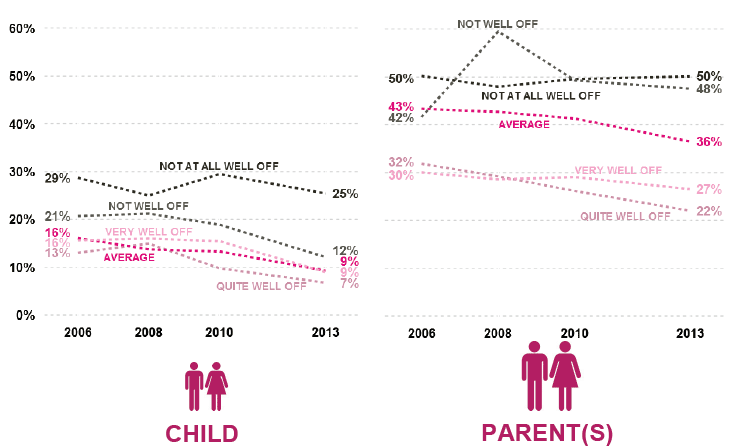
Base: all 15 year olds, 2006-2013 (full bases in Appendix A, Table A.13)
The variations in the different deprivation measures may be due to various factors - for example, pupils may not be aware of how well off their family is financially and how that compares to other families and are more likely to compare themselves to their peers. However, the three measures all broadly show the same thing - as deprivation increases, the likelihood of the child being a regular smoker also increases.
GENDER
Historically, girls of both age groups have been more likely to be regular smokers than boys, but this gap has decreased over time and is now extremely small (see Figures 2.3 and 2.4). However, girls remain over-represented in several risk groups.
During the logistic regression modelling (see Chapter 6 for more information), it was found that with all the factors considered equally, girls were actually less likely to be regular smokers than boys. While counter-intuitive, what this means is that girls are not intrinsically more likely to smoke, but the factors that lead 15 year olds to become regular smokers have a greater effect on girls than boys, explaining the difference between them.
The regression was therefore carried out on boys and girls separately to identify the factors closely associated with each gender. The results are shown in Figure 5.4 and 5.5[39]. More information on the logistic regression can be found in Appendix C.
For some of the factors, the differences between genders are minor, such as paternal knowledge and going to the cinema and truanting. It should be noted as well that self-reported family wealth and free school meals come up for girls and boys respectively but not for both - this is likely to be because they cover similar areas and one is slightly stronger than the other in each case so that is the one found to be significant.
For others, the difference is quite large: spending evenings out with friends is a much stronger indicator of smoking in girls than boys, for instance, while playing a sport weekly has a much stronger association with non-smoking boys than girls. In particular, SDQ score is a predictor of regular smoking in girls but is not significant at all for boys. Rural/urban classification is also shown as a strong factor for girls, though it is unclear why - it is possible that the variation found in this factor by the model was not adequately explained by any of the other variables and that is why it is reported as significant, even though its effect is not immediately apparent.
The factors presented here do not imply direct causation but an association which may be complex. For instance, the reason pupils who go to the cinema weekly may be less likely to smoke could be that they are likely to be better off than other respondents. The logistic regression does not imply this, however, so we cannot infer reasons for an association, only show that one exists.
Figure 5.4 - Association with being a non-smoker for 15 year old girls
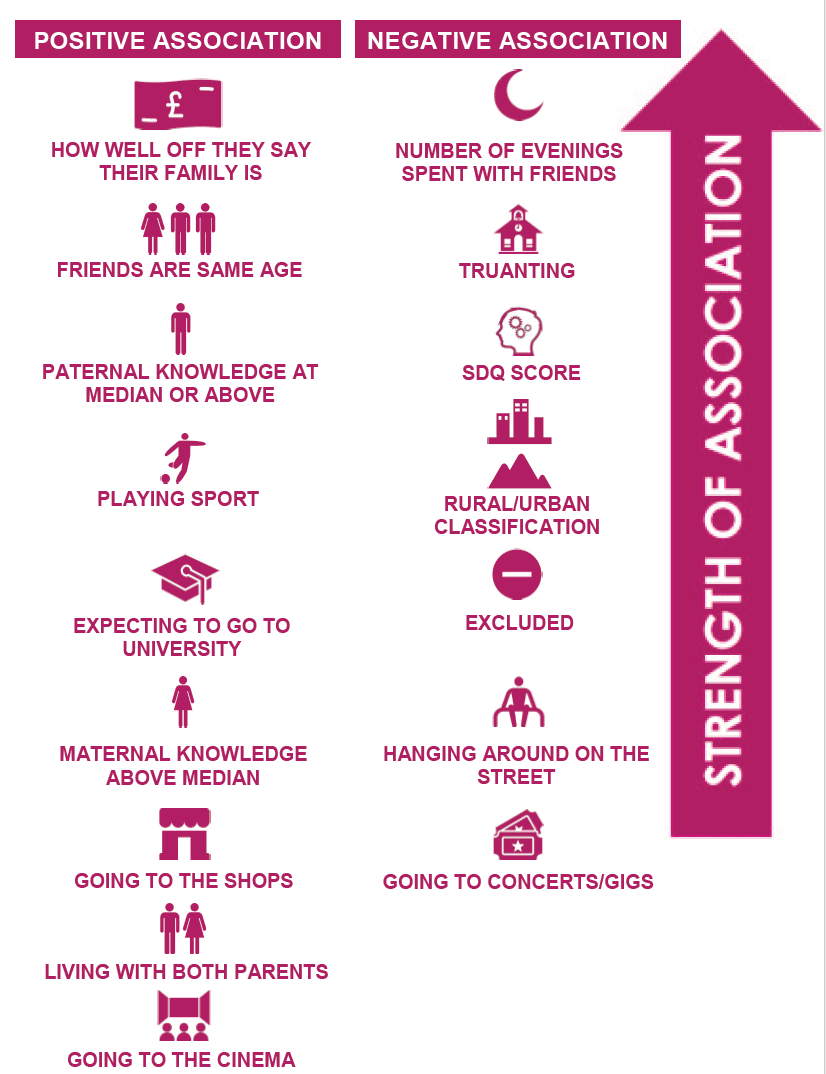
Figure 5.5 - Association with being a non-smoker for 15 year old boys
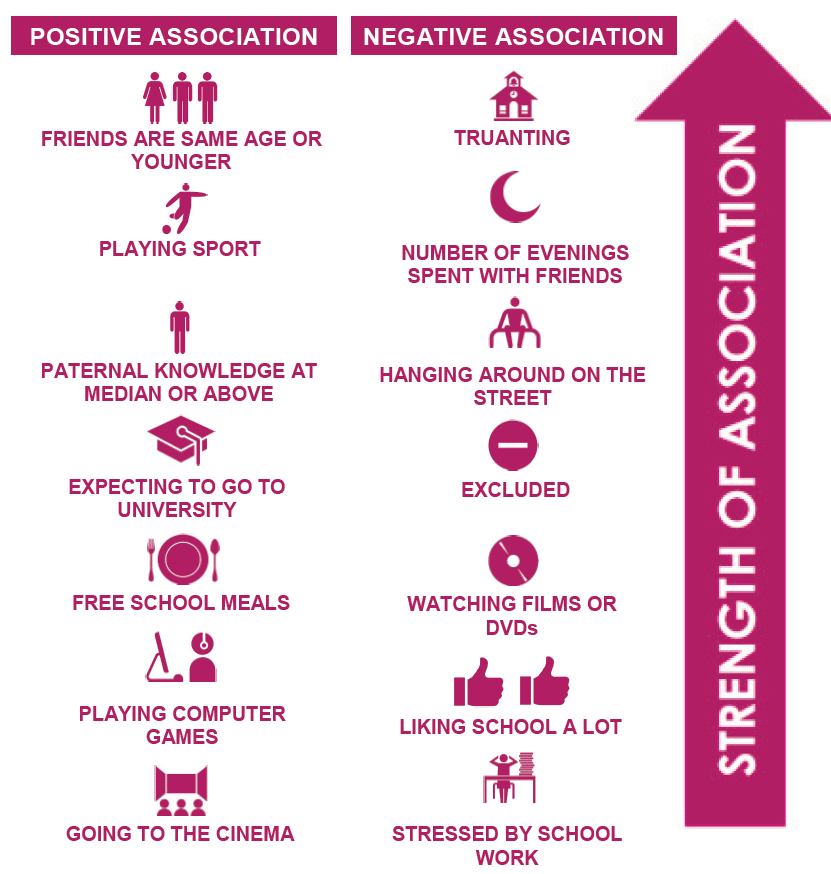
ETHNICITY
The population of Scotland is predominantly white: across all years when ethnicity data were collected (2002 to 2013), 94% of respondents identified themselves as such. The small sample sizes of other ethnicities means identifying a reliable trend over time is not possible. Across the aggregated data-set for 2002 to 2013, pupils who identified themselves as black or Asian were less likely to be regular smokers than white children. Pupils who said they were mixed race were most likely to be regular smokers (Figure 5.6).
Table 5.6 - Percentage of all pupils who regularly smoke by ethnicity
| REGULAR SMOKER | OCCASIONAL SMOKER | NON-SMOKER | |
|---|---|---|---|
| WHITE | 9% | 4% | 87% |
| ASIAN | 5% | 4% | 91% |
| BLACK | 8% | 4% | 88% |
| MIXED | 11% | 5% | 80% |
Base: respondents providing their ethnic identity and smoking status (2002-2013) - White (120721); Asian (2651); Black (662); Mixed (3545)
Contact
Email: Fiona MacDonald
There is a problem
Thanks for your feedback